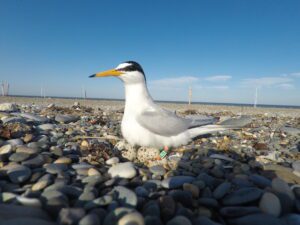Marine Policy Officer, Rosalind Skillen, speaks to Little Tern Project Manager, Brian Burke about the The Little Tern Conservation Project in Kilcoole.
This is a National Parks and Wildlife Service project which is managed by Birdwatch Ireland. It is by far the largest Little Tern colony in Ireland, having grown from under fewer than 20 nesting pairs in the 1980s to 274 pairs in 2024.
Can you tell us a bit about Little Terns, the species you work to protect?
Little Terns are fantastic little birds. They weigh around 50g, so around half the size of a Blackbird. Terns were historically known as ‘sea swallows’ as they have a shape similar to a Swallow, with long pointed wings and forked tails, but are white and ‘marine’ in nature like a gull. These tiny little birds migrate to West Africa in the winter, and return to a number of out-of-the-way sand and shingle beaches around the Irish coast to try and raise their young. As seabirds that rely on a diet of fish, they’re excellent ecosystem indicators to give us an idea of what goes on beneath the waves. If Little Terns are doing well and raising young successfully, it must mean that the sea around their colony has enough fish to support them.
Have you noticed any changes in populations or behaviours over the years?
The biggest change has been the numbers at the Kilcoole colony. We now have by far the biggest colony of Little Terns in Ireland, and one of the biggest in all of Ireland and the UK, and that’s thanks to many years of conservation efforts by the National Parks and Wildlife Service and BirdWatch Ireland. I think it’s a real testament to long-term funding and long-term efforts. Sometimes it can take a few years for your efforts to be rewarded, but when it comes to scarce and declining species, we need to stick with it. We still have occasional bad years at Kilcoole, but importantly we now have many more good years than bad and the Kilcoole and east coast population as a whole are growing.
How do you involve the local community at Kilcoole?
The local community in Kilcoole are fantastic every year. They’re always delighted to see the Terns back, and indeed are sometimes concerned towards the end of April when we haven’t got all our fencing up yet! Something as simple as people walking on the beach, and letting dogs off leashes, are some of the biggest threats to Little Terns but everyone at Kilcoole is very happy to steer clear of the nesting area once the terns are back, and that makes a big difference. There’s a real sense of pride in Kilcoole around having these birds pick here to nest, and there’s a ‘Little Tern Playground’ in Kilcoole and one of the schools even has terns on their crest! Ultimately, many conservation problems are people problems rather than ecological problems. We know what most species need to thrive, but we need public buy-in to actually provide it. Thankfully the local community at Kilcoole are incredibly supportive.
What are the biggest threats to Little Terns in Kilcoole?
The biggest threats are predators, and waves. A single fox, or a determined Hooded Crow, Rook or Mink, could do a huge amount of damage in a very short space of time to a colony like this. Unfortunately in recent decades we’ve made the Irish landscape perfect for ‘mesopredators’ like these, and much less suitable for specialist species like the Little Tern. So we try and restore that balance on the beach at Kilcoole to give the Terns a chance. Similarly though, windy days, combined with a high tide can spell disaster for the colony and we’ve had huge amounts of eggs and chicks washed away in a couple of hours. Unfortunately there’s nothing you can do to stop the sea swell when conditions are like that, and with climate change and stormier and more unpredictable weather each summer it’s something we’re going to keep seeing in the years ahead.
What can we do to support your work?
I think the Kilcoole Little Tern conservation project is a fantastic example of what can be achieved with long-term funding and continued efforts to address conservation problems and develop expertise over time. Kilcoole wasn’t an immediate success, but over time we’ve worked closely with NPWS to address the issues the birds face and to get to the stage where we have more good years than bad years. I think we need more protected sites, offshore and onshore, and we need to get plans and resources in place to reverse the biodiversity declines that are happening. Monitoring is important too – we need to know what we have, where we have it, and how it’s changing over time. The only way we’ll know if protection and conservation efforts are working is with continued monitoring. And importantly, we need to start now – there’s no time to waste!
[Photos 1-3: Brian Burke; Photo 4 (Ringing Photo): Oonagh Duggan]The Kilcoole Little Tern Project is an NPWS project run by BirdWatch Ireland under a competitive tender agreement in 2024.








